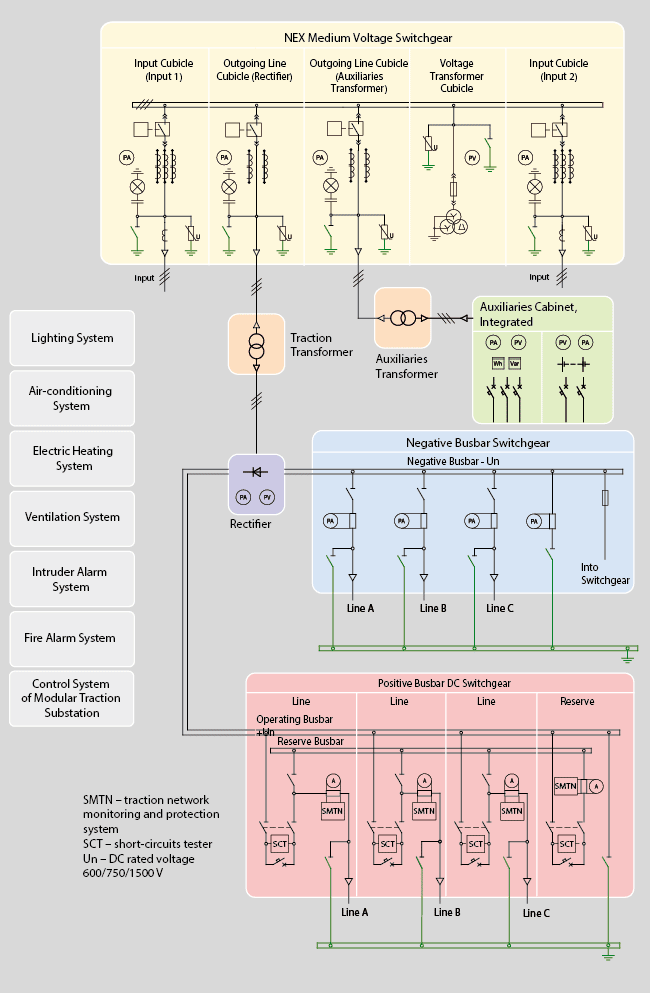Single-line diagram of the A.C. Electrical system (on photo 110kV substation; credit: energo-pro.ge) • Transmission system and • Distribution system Each part can again be sub-divided into two: primary transmission and secondary transmission and similarly, primary distribution and secondary distribution and then finally the system of supply to individual consumers. A typical layout of a generating, of a large system would be made up of elements as shown by a single-line diagram of Figure 1 although it has to be realized that one or more of these elements may be missing in any particular system. For example, in a certain system, there may be no secondary transmission and in another case, when the generating station is nearby, there may be no transmission and the distribution system proper may begin at the generator bus-bars.
11 KV Bus at 33 /11 KV Jampaijala S/S. 11 KV Out Going Feeder. 2x3.15 MVA 33/11 KV Power Transformer. CTR 200/1-1 A. CTR 100/1-1-1 Amp. CTR 150-50 /1-1 A. Single Line Diagram of 33/11 KV Jampaijala for Tender Purpose only. 100 KVA 11/0.433 KV Station. 33 KV line from Takarjala 33/11 KV S/S.
Now-a-days, generation and transmission is almost exclusively three-phase. The secondary transmission is also 3-phase whereas the distribution to the ultimate customer may be 3-phase or single- phase depending upon the requirements of the customers. Figure 1 – Single-line diagram of transmission and distribution network. Central station where power is generated by 3-phase alternators. In Figure 1 C.S. Represents the central station where power is generated by 3-phase alternators at 6.6kV or 11kV or 13.2kV or even 32 kV.
The voltage is then stepped up by suitable 3-phase transformers for transmission purposes. Taking the generated voltage as 11 kV, the 3-phase transformers step it up to 132 kV as shown. Primary or is carried out at 132 kV*. The transmission voltage is, to a very large extent, determined by economic considerations. High voltage transmission requires conductors of smaller cross-section which results in economy of copper or aluminium.


But at the same time cost of insulating the line and other expenses are increased. Hence, the economical voltage of transmission is that for which the saving in copper or aluminium is not offset by // • The increased cost of insulating the line, • The increased size of transmission-line structures and • The increased size of generating stations and substations. A rough basis of determining the most economical transmission voltage is to use 650 volt per km of transmission line.
For example, if transmission line is 200 km, then the most economical transmission voltage will be 200 × 650 ≅ 132,000 V or 132 kV. The overhead high-voltage transmission line next terminates in step-down transformers in a substation known as Receiving Station (R.S.) which usually lies at the outskirts of a city because it is not safe to bring high-voltage overhead transmission lines into thickly-populated areas. Here, the voltage is stepped down to 33 kV. It may be noted here that for ensuring continuity of service transmission is always by duplicate lines. 33 KV power substation (photo credit: statensolar.com) From the Receiving Station, power is next transmitted at 33 kV by underground cables (and occasionally by overhead lines) to various substations (SS) located at various strategic points in the city. Url2 Sifteam E1 Download.
This is known as secondary or low-voltage transmission. From now onwards starts the primary and secondary distribution. At the substation (SS) voltage is reduced from 33kV to 3.3kV 3-wire for primary distribution. Consumers whose demands exceeds 50 kVA are usually supplied from SS by special 3.3 kV feeders. The secondary distribution is done at 400/230 V for which purpose voltage is reduced from 3.3 kV to 400 V at the distribution substations. Feeders radiating from distribution substation supply power to distribution networks in their respective areas.
If the distribution network happens to be at a great distance from substation, then they are supplied from the secondaries of which are either pole-mounted or else housed in kiosks at suitable points of the distribution networks. The most common system for secondary distribution is 400/230-V, 3-phase 4-wire system. The single-phase residential lighting load is connected between any one line and the neutral whereas 3-phase, 400-V motor load is connected across 3-phase lines directly. It should be noted that low-voltage distribution system is sub-divided into feeders, distributors and service mains. No consumer is given direct connection from the feeders, instead consumers are connected to distribution network through their service mains. Distributors are, in many ways, similar to the D.C.
Distributors as regards their constructional details and restrictions on drops in voltage. Let’s summarize // Summarizing the transmission and distribution voltages we have // • Generating voltage: 6.6, 11, 13.2 or 33 kV. • High voltage transmission: 220 kV, 132 kV, 66kV. • High voltage or primary distribution: 3.3, 6.6 kV. • Low-voltage distribution: • A.C. 400/230, 3-phase, 4-wire • D.C.